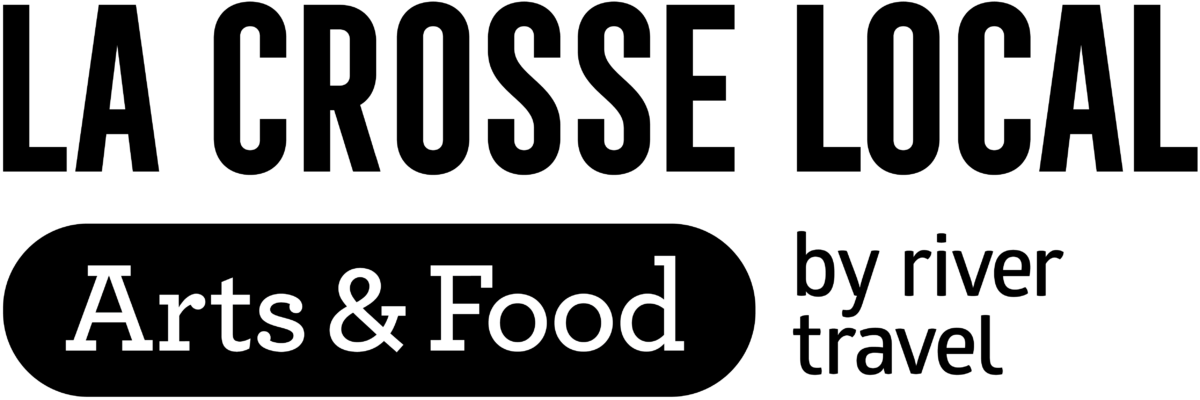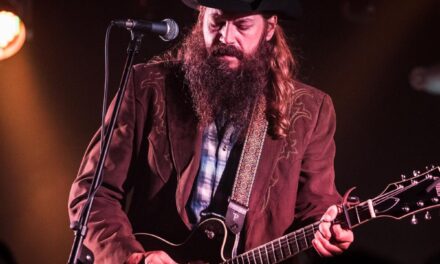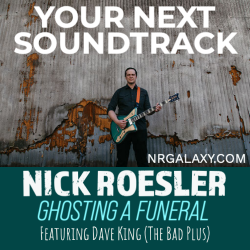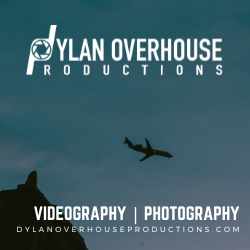It’s all about the history of the worker, telling the stories of workers of the past, it’s the style and history combined to make something new…
We talked with artist Tyler Voorhees about influences, his process for creating new work, murals, hidden messages in his paintings, the Lamplighter exhibit, and what’s next. Check out his work at Artspire’s Art Fair & Sale on Saturday, June 11, 2022.
Special thanks to our Podcast Sponsors!
Transcript
Amy Gabay 00:00
This podcast is brought to you by People’s Food Co Op, a community owned grocery store in downtown La Crosse, Wisconsin and Rochester, Minnesota that promotes local farmers and producers through an emphasis on fresh, healthy, sustainable food. Anyone can shop, everyone is welcome. For more information, visit them online at PFC.coop. This podcast is also brought to you by Trempealeau County Tourism. Whether your idea of fun is bicycling, hiking or canoeing, afterwards head into the heart of one of their welcoming communities to experience historic architecture, independent shops and locally owned dining establishments. Visit Trempealeau County Tourism online. We talked with artist Tyler Voorhees about influences, his process for creating new work, murals, hidden messages in his paintings, the Lamplighter Exhibit and what’s next. Check out his work at Artspire’s Art Fair and Sale Saturday, June 11th. You can find more conversations, food reviews, live music and events on our website lacrosselocal.com. I’m Amy.
Brent Hanifl 01:07
I’m Brent.
Amy Gabay 01:08
And this is La Crosse Local.
Tyler Voorhees 01:10
My name is Tyler Voorhees. I was born in Tulare, South Dakota, population 248. What led me to art, gosh, I’ve always drawn. I remember as a little kid, like, first memories of making art was to, like try to copy what I saw on the coloring books. I remember trying to draw it. And I can get pretty close, you know, and I was like, wow, this is really cool. And of course encouragement from the parents always helps like, wow, look at what you did. I remember making art from a young age and and always loving to draw. And I still love to draw. Eventually, that led into like drawing caricatures like those big head guys with a little bodies. I remember seeing those and thought that was really a cool way to draw somebody. And so I started making those of like all my family members and all my friends. And that also started me on this path of like playing with proportions of people. And you know, making certain things bigger and smaller, and how that changes how you perceive the figure. Even though I would have never described it that way, like looking back, I can see that evolution. And then you know, in high school, I you know, I made a lot of art on the side. But we didn’t have an art class. I had no art classes in high school because I was in such a small town. But continue to just like draw and play around with things. And I remember finding like Salvador Dali and some of the Surrealists that really led me to see the different proportionality as being like a fine art, kind of a fine art packaging with it, you know, like a really beautiful finished painting that features that disproportionate figure. And then Tim Burton and a sculptor named Jack Onetti, you know, these are kind of my biggest influences as far as the style that I’m reaching towards. And then yeah, I went to college started in other paths, because I was never told you could be an artist and I was just unhappy in architecture. And in, you know, the sciences, I was interested, but I just wasn’t excited. And so I came back to art and got an art degree and kept on the side. And then eventually it became my full time gig. And so that’s what I do for a living now, and I can’t believe it most days.
Brent Hanifl 03:27
You kind of mentioned it there with Tim Burton. And like I instantly when I saw your work, which I’m relatively new the last couple of weeks when we reached out, I thought of instantly like American Gothic painting, slash Tim Burton, you know, your work is very unique. And in some sense, like you just referencing there, is there any other inspirations you use, like music or anything like that? Or is there anything that?
Tyler Voorhees 03:48
I mean, I listen to a lot of music while I make art. And I think that definitely feeds into the energy that I bring to it. Like most creatives, I get doubtful about what I’m doing or I just, it takes some courage, you know, to like, go for it. And music helps give me that courage I found, especially with like something big like a mural, I put on some rock and roll. And you know, like old Nirvana is kind of my thing right now, or some bold hip hop or something just to get my energy going. I don’t know about visually that music inspires it. It’s just more like the energy behind it. But I’m also really like, I take a lot inspiration from obviously history. If you look at my work, you see, it’s all about the history of the worker and about telling the stories of workers of the past. It’s the style and the history combined to make something new. So history is like a huge influence. And I get that influenced by reading about history, looking through a lot of old photographs. Some of my favorite photographers like in the early 1900s that went around and photographed everyday people. Like I just treasure those collections and definitely draw inspiration from them. You know you mentioned American Gothic, that painting. Have you seen that painting I did of that, like the version I did?
Brent Hanifl 05:04
No, I didn’t know, I didn’t know that.
Tyler Voorhees 05:06
Oh, yeah, I’ll see if I have one here. I’ll send you a picture later. But so for the people listening in aren’t familiar with my work, I do these really elongated characters that depict old jobs. I call them the Jobs Of YesterYear. And so with American Gothic, you know, I love that. I just love that simple, humble portrait of that painting by Grant Wood, but I wanted to change it and do something new with it. So I did a version called The Haymakers, I made mine, a husband and wife. I know his looks like a husband or wife, but it’s a father and daughter, if you look at the history of it. But I made mine a husband and wife standing there with their old sites, and a pitchfork and kind of their old tools of the trade of putting up hay. And standing in front of this giant like field of bales, of round bales that kind of go into the distance behind them. To me, history feeds the work like me learning and researching history is how I kind of take it in, and then I breathe it out in the studio, when I’m making the work.
Brent Hanifl 06:07
Looking at your work, it does kind of seem to follow like a storyline through most of your work here. It sounds like you dive into a lot of sort of detail into it. In terms of just research is the process fast when you’re coming up with ideas or is it kind of slow and steady? Or how do you?
Tyler Voorhees 06:26
I travel a lot, and I talked to a lot of people and a lot of the ideas come from those interactions. Always just part of why I love the whole art festival circuit that we do is it allows me to connect with people around this theme and just hear their stories. You know, oh, my grandfather was a mailman and told me about delivering snow and the 10 foot Blizzard, you know, things like that will often just give me visual cues that might make their way into a painting at some point. And you know, to keep track of those, I keep a running list in my studio here just of all the jobs that are on my docket or things I think of when I think of it, I’ll just jot it down. And then when it’s time to make art, like right now I’m in a two week period before my next show where I’m just going to make as many things as I can. I just look at that list, which stories grabbed me. And once I find you know which one, two to three, I’m going to do in that little batch, start researching and start reading as much as I could find online. If I haven’t done it before, you know, look up what I can find on the history of it. And then as I learn about it, then the idea starts to form. And you know, I make little sketches about it and then start on the actual painting. I think sounds like a really long drawn out process, you know, but I’m pretty decisive about it. At this point. I’ve got the look down, I’ve got my composition sense is getting more decisive. I can do them pretty quickly, relatively speaking, but I don’t know you know what’s quick? Each artist works at his own pace. And one thing I didn’t mention is that in every painting as part of the story behind that job, I put something in there that shows how that job changed over time. So like with The Haymakers piece that I told you about, the couple standing there with the old farm implements, the old farm tools, the round bales behind them actually shows the evolution of farming, because you would never make a round bale with those old tools you’d use a baler and a tractor. So it’s often hidden like that. It’s subtle. But each painting I do in the Jobs of YesterYear will have that little bit of the evolution of that job or industry hidden in there.
Brent Hanifl 08:38
That’s pretty exciting. I’m actually, while you’re talking to me, I’m kind of digging through your different work. You got a shop page, you also have murals, which we could touch on, too. I guess you know, I also pulled up the one with the hay bales, the American Gothic sort of one. It’s really interesting. For people that want to come check you out at the Art Fair and Sale at Artspire Saturday, June 11th. What can people expect? You know, I’ve already gone to your shop page and I see quite a few prints that I’m already thinking about getting here. But what can people expect when they come to your booth?
Tyler Voorhees 09:06
I have a mix of both original paintings and prints or reproductions of the original paintings. A lot of my paintings are very tall, like, you know, my figures are really tall. And so I paint on wood panels I have. My brother actually makes these, you know, two foot by six inch tall wood panels that I often paint on. In fact, that’s what I’m working on right now. I’ve got a couple in the works. I’ve got a deep sea diver and a plague doctor, which has been a really popular one recently. Yeah what you can really appreciate in person with the originals is that the background is painted on a wood panel. Yeah, and so then after I paint the background, then I make the figure out on paper. And so its all these little torn bits of paper. So I’ll trim all this off the edges and then paint on the front of it to finish out the details of the figure and then I fixed that to the wood panel. So the originals, what’s really nice about them is they have this really beautiful little subtle dimension to the figures to the workers and the paintings. And so they stand out just that little bit more. And you’re just drawn to them. And then of course, the reproductions are like a flat reproduction of that. So they don’t have the same dimension, but they still look good.
Brent Hanifl 10:25
You also do murals. So is that something that’s relatively new for you? Or how does that even work really?
Tyler Voorhees 10:33
Yeah, that’s what, when I started I was like, how does this even work? I don’t, I just want to make a big painting, how do I do this?
Brent Hanifl 10:40
Because it definitely looks different. You know, I mean, similarities, that sort of stuff. It looks like almost a little bit more modern.
Tyler Voorhees 10:46
Yeah, well, you know, my wife and I, and she’s a big part of the business. I haven’t even mentioned her. She’s like the business side of it, the visionary. She’s also a graphic designer. So she has the kind of visual acumen and skills to make great compositions and great choices in that way. So on the murals, we work together more than just on my regular work. What we found is yeah, with public art, we’ve kind of gone more into like a more vibrant look, with the murals. There’s a little bit more color, there’s a little bit more playfulness with it. And it’s really fun. I mean, just the physical nature of it painting on that scale, is just a blast to me. I just love like this huge wall, big bold statement. And it’s fun to just kind of conquer it in a way and put a big piece of art on there and figure out how to do that. You know, as far as the technical aspect of it, I’m sketching it in my sketchbook to scale, and then either trying to project it if I can with a projector, or if that’s not possible, then I’ll grid it out, more or less, just step back a lot. Because it’s so easy to get tripped up with the dimensions of it when you’re up close. Most muralists use a grid system, or the projection method to keep your proportions right at that scale. You know, we take this whole theme about workers and celebrate them with murals, either workers that are more native to that area that have a local history, or that represent something in some way. So we did one in Mexico was one of the most recent ones. And we did a Lamplighter, which was a person who went around and lit up street lamps as they faded in the night to keep the streets lit and safe. The lady who had us come down to do that, she had a history of being a literal Lamplighter in that town, she paid the local government to light the streets because she owned a restaurant and the workers of her restaurant would walk home in darkness on these dark streets. So she paid to have these lights replaced and literally like lit the streets. So this Lamplighter has a special meaning to her. And so we painted a Lamplighter in Akumal, Mexico. I love doing it. I love the public aspect of it. It’s just art for everybody. And it makes a public area more beautiful, and it brings the community together. And I just love like the power of public art.
Brent Hanifl 13:14
Is there anything coming down the line for you, that’s exciting the next couple of years, a year or two?
Tyler Voorhees 13:20
Yeah, we’ve always got our eye on the horizon and talk big picture stuff. And we’ve got a few possibilities there. You know, the murals are always an exciting opportunity because we love to travel. We have two young boys that are five and nine. And they come with us and they’ve started to kind of help with the murals a little bit. We don’t have anything like nailed down just yet with murals, but there’s always opportunities coming up and there’s some irons in the fire there. And then, you know, during the pandemic, we did a giant sculpture of a Lamplighter, had a lot of fun doing that. And we welded together all these tools to create this 13 foot tall sculpture of a Lamplighter. We had some challenges with it because it was a whole new thing to us and took us a while to figure it out. And we’re still figuring it out. We’re trying to make it interactive, where people help illuminate the light on the sculpture, but we just really loved the sculpture aspect of it. And so another possibility is moving more into that and kind of bringing that more into like smaller scale work that could go in people’s homes, or perhaps getting more public art contracts to do more sculptural work as well. There’s new directions in painting that I’m exploring. And so there’s always new things to try and I try to be the type of artists that doesn’t get too comfortable. That’s always expanding and always learning and trying new things. Every painting is an opportunity to grow in that way.
Brent Hanifl 14:48
You know, just looking at your work to me, it kind of spans so many genres in terms of you know, the I guess it’s kind of not older but you know, just kind of older sort of ways people work you know, using the history component and also contemporary component. I know I’m gonna stop down at Artspire and buy something at least. If people want to find out more or maybe you know, they just want to check out your shop, what’s the best avenue for them to go to?
Tyler Voorhees 15:11
Yeah, I think the website, tylervoorheesart.com is gonna give you like the biggest spreads of my work. Voorhees is two O’s, two E,’s. But yeah, if you just Google Tyler Voorhees Art should get you there. And then the Lamplighter sculptures actually on its own page, it’s called the lamplighterart.com. And you can see the sculpture and the mural I talked about in Mexico, those are probably the best ways to keep up with it. Social media, we’ve been drawn down a little bit with Facebook and Instagram. So you won’t see a lot of new posts for us there. But we’ve been putting more effort into Patreon, which is a creative social media network full of just creatives. And you can find us on there at patreon.com/voorheesartcollective, because it includes my wife, she writes on there and me and then as the boys get older, you know, they’ll have a place to put their work as well. Yeah, we’re on there a lot. And in fact, that’s how we found Artspire believe it or not. A band that we love and have followed for years called Cloud Cult is coming to Artspire, and we are one of their patrons on Patreon. And so we keep in touch with what they’re doing and see where they’re going. And we couldn’t believe they’re coming like to this awesome little festival in La Crosse, Wisconsin, which isn’t too far from us. And so we were on board at that point. Yeah, we’re excited to see them on Friday.
Amy Gabay 16:38
La Crosse Local Podcast is a production of River Travel Media. Do you have an interview idea you’d like to share with us? Message us on Facebook at La Crosse Local. Find out more about us at lacrosselocal.com and you can subscribe to the La Crosse Local Podcast on your favorite podcast app. If you like us, rate us five stars. We appreciate it.
About La Crosse Local
La Crosse Local is an arts, food, and entertainment podcast and publication for La Crosse County and its surrounding communities.
Find us in your favorite podcast app.










